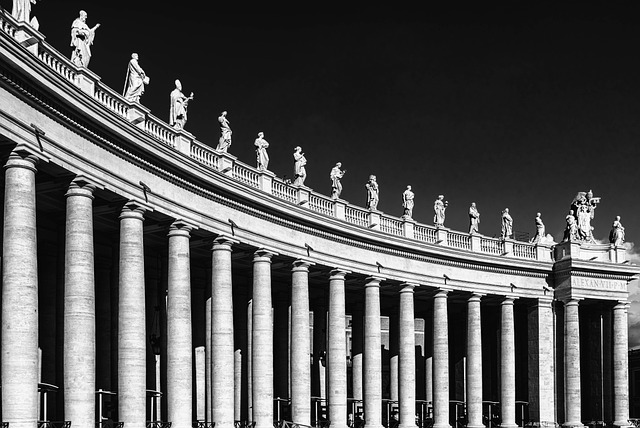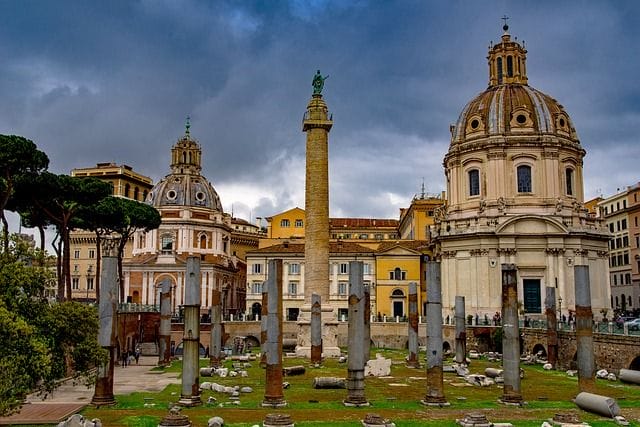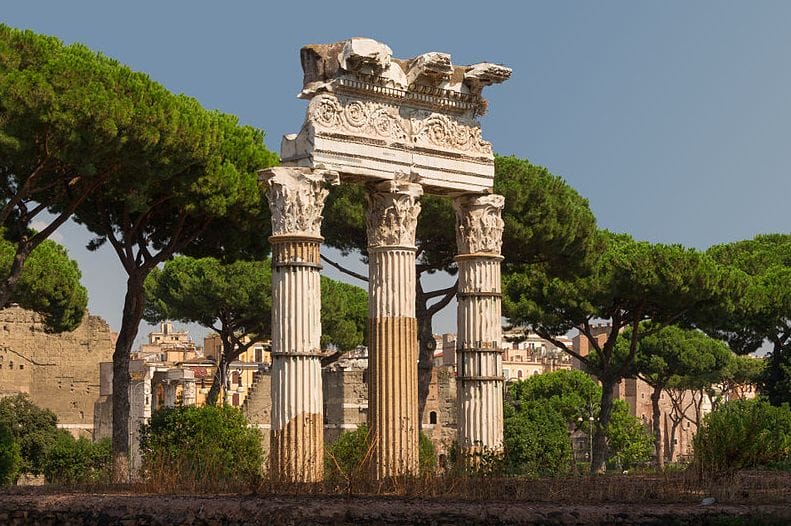Last Updated on November 27, 2023 by Vladimir Vulic
Have you ever marveled at the majestic columns of ancient Rome, wondering about their history and influence on modern architecture? Roman columns are not only a testament to the grandeur of a bygone era, but also an enduring inspiration for architects and designers worldwide. In this exploration, we’ll delve into the history, types, and famous examples of Roman columns, as well as their impact on contemporary structures across the globe.
From the iconic Doric, Ionic, and Corinthian columns to the awe-inspiring triumphal columns commemorating great victories, we will uncover the fascinating stories and details behind these architectural marvels. So, let us embark on this journey through time, admiring the enduring beauty and symbolism of Roman columns and their lasting influence on the world of architecture.
Short Summary
Roman columns, including Doric, Ionic and Corinthian styles, are iconic architectural features that symbolize the grandeur of the Roman Empire.
Famous Triumphal Columns such as Trajan’s Column showcase their political and cultural legacy.
Modern cities around the world feature these impressive structures to commemorate Rome’s rich history and influence on architecture today.
Roman Columns: A Brief Overview

In ancient Rome, columns were closely associated with the concept of Triumph and were erected as monuments to honor emperors who achieved numerous victories. These architectural masterpieces served as a testament to the might and glory of the Roman Empire, showcasing the skill and artistry of Roman architects and craftsmen. The three primary types of Roman columns – Doric, Ionic, and Corinthian – each have their unique characteristics and are found adorning numerous historical buildings throughout Rome.
Apart from the three main column types, ancient Rome also boasts renowned triumphal columns such as Trajan’s Column, Column of Marcus Aurelius, and Column of Phocas. Each of these columns tells a captivating story of the emperors they were built to honor and the victories they achieved.
Now, let’s delve deeper into the distinct styles and features of Doric, Ionic, and Corinthian columns.
Doric Columns
The Doric column, known as the most basic type of Roman column, is characterized by a simple, rounded capital at the top, a heavy fluted or smooth column shaft, and no base. The style features vertical and parallel flutes, creating a sense of strength and stability. A prime example of Doric columns in Rome can be found along the arches of the Colosseum, standing tall and proud as a testament to the architectural prowess of ancient Rome.
Despite its simplicity, the Doric column has remained an iconic and enduring element of ancient architecture. Its straightforward design and solid structure have made it a popular choice for numerous historical buildings, exemplifying the power and grandeur of the Roman Empire.
Ionic Columns
The Ionic column, another of the three main types of Roman columns, is distinguished by its volutes at the top, a base, and a more slender profile compared to Doric columns. The elegant swirls of the volutes and the taller, more graceful shaft give the Ionic column a sense of refinement and sophistication, making it a perfect choice for buildings that required a touch of elegance and ornamentation.
In Rome, Ionic columns can be located in the Colosseum, showcasing the versatility and adaptability of Roman architecture. This style, with its graceful lines and decorative features, has continued to inspire architects and designers throughout history, leaving an indelible mark on the world of art and architecture.
Corinthian Columns
The Corinthian column, arguably the most ornate and luxurious of the three main column types, is distinguished by its fluted shafts and ornate capitals adorned with acanthus leaves and elaborate flowers. Its slimmer design compared to the other two column types, combined with the opulent decoration, gives the Corinthian column an air of sophistication, luxury, and grandeur.
Notable examples of corinthian columns include the Column of Trajan, Column of Marcus Aurelius, and Column of Phocas. These majestic columns stand as enduring symbols of the magnificence and opulence of ancient Rome, showcasing the craftsmanship and artistic prowess of the architects and sculptors who brought them to life.
Famous Roman Triumphal Columns

Roman Victory Columns, such as Trajan’s Column, Column of Marcus Aurelius, and Column of Phocas, were constructed to commemorate military victories and pay tribute to the emperors who led their armies to triumph. These impressive structures provide a fascinating glimpse into the history and culture of the Roman Empire, showcasing the artistic talent and architectural ingenuity that characterized the civilization.
Each of these columns tells a unique story of victory and conquest, adorned with intricate reliefs and sculptures that capture the essence of the Roman Empire. Let’s explore the history and significance of these famous Roman Triumphal Columns.
Trajan’s Column
Trajan’s Column, a triumphal column commemorating the military success of Emperor Trajan in Dacia, features a mesmerizing spiral relief that depicts the emperor himself, soldiers, landscapes, and actual events from the Dacian Wars. The column, standing at an impressive 100 Roman feet (around 30 meters) in height, presents the narrative of Trajan’s campaign in chronological order.
The well-preserved column not only illustrates the conflict between Rome and the Dacians, but also the prosperity that Trajan’s victory brought to the empire, as the region was abundant in minerals and other resources. The historical significance of Trajan’s Column is immense, as it provides valuable insights into the military, political, and social aspects of the Roman Empire.
The column has stood the test of time, showcasing the indomitable spirit and artistic brilliance of ancient Rome.
Column of Marcus Aurelius
The Column of Marcus Aurelius, constructed in 176 A.D. to commemorate the emperor’s successes, was inspired by Trajan’s Column. Standing at 42 meters in height and made of marble from Luni, this impressive column showcases the military prowess and victories of Marcus Aurelius.
The construction of the Column of Marcus Aurelius began in 180 AD, during the final year of Marcus Aurelius’ Empire, and was completed in 193 AD under the reign of Emperor Commodus, his successor.
The Column of Marcus Aurelius, like Trajan’s Column, serves as a powerful reminder of the military might and architectural genius of ancient Rome. These enduring monuments continue to captivate and inspire, providing a fascinating glimpse into the history and culture of a bygone era.
Column of Phocas
The Column of Phocas, a classic example of Greco-Roman Corinthian architecture, is a white marble column measuring 13.6 meters in height, situated adjacent to the Oratorium Tribune in the Roman Forum. Erected to honor the victories of Emperor Phocas, the column’s location, prominently placed above the Roman Forum and in close proximity to the Triumphal Arch of Septimius Severus, highlights its significance and grandeur.
The Column of Phocas, like the other triumphal columns, stands as a testament to the power and prestige of the Roman Empire. These monuments, each with their unique history and style, continue to captivate and inspire, providing a fascinating glimpse into the lives and achievements of the emperors they were built to honor.
Roman Columns in Architectural Landmarks

Roman columns are not confined to the ancient city of Rome; they can be found in numerous architectural landmarks around the world, showcasing their enduring influence and popularity. From the Roman Forum to the Pantheon and the Temple of Venus Genitrix, these iconic columns continue to inspire awe and admiration for their beauty, craftsmanship, and historical significance.
In this section, we’ll explore the presence of Roman columns in these architectural landmarks, shedding light on their history, design, and the stories they tell. Join us as we delve into the captivating world of Roman columns in the Roman Forum, Pantheon, and Temple of Venus Genitrix.
The Roman Forum
The Roman Forum, once the bustling center of ancient Rome, was a public square where people congregated to debate politics, religion, and other matters of public interest. This historic site, adorned with numerous Roman columns, showcases the architectural prowess of ancient Rome, with structures such as the Senate House, the Temple of Saturn, and the Temple of Vesta.
One of the most visually impressive and well-preserved buildings in the Roman Forum is the Temple of Antoninus and Faustina, which stands as a testament to the skill and artistry of Roman architects and craftsmen. The Roman Forum, with its iconic columns and historic structures, continues to captivate the hearts and minds of visitors from around the world.
The Pantheon

The Pantheon, a temple in Rome dedicated to all the gods of ancient Rome, is renowned as one of the most well-preserved ancient Roman buildings. Its impressive columns, made of monolithic blocks of grey Assuan marble with white marble Corinthian-style capitals, showcase the architectural ingenuity and craftsmanship of ancient Rome.
Standing tall and proud, these magnificent columns not only pay tribute to the gods they were built to honor, but also serve as a testament to the enduring influence of Roman architecture. The Pantheon, with its awe-inspiring columns and domed structure, continues to inspire architects and designers worldwide.
The Temple of Venus Genitrix
The Temple of Venus Genitrix, constructed by Julius Caesar in 46 BC, was dedicated to the Roman goddess Venus in commemoration of the purported lineage of his family. This ancient temple, adorned with Roman columns, stands as a testament to the architectural prowess and artistic talent of ancient Rome.
Today, the Temple of Venus Genitrix serves as a constant reminder of the rich history and cultural heritage of Rome, showcasing the architectural ingenuity and craftsmanship that characterized the civilization. Its columns, like those found in other Roman architectural landmarks, continue to inspire and captivate, leaving an indelible mark on the world of art and architecture.
Modern Influence of Roman Columns

The influence of Roman columns is not confined to the past; their architectural legacy can be seen and felt in numerous contemporary cities around the world. From Venice, Italy to Barcelona, Spain, and St. Petersburg, Russia, the awe-inspiring beauty and timeless elegance of Roman columns continue to captivate and inspire architects, designers, and visitors alike.
In this section, we’ll explore the modern influence of Roman columns in these three cities, showcasing the unique ways in which they have been incorporated into contemporary structures and landscapes. Join us as we delve into the captivating world of Roman columns in Venice, Barcelona, and St. Petersburg.
Venice, Italy
In Venice, Italy, the Column of San Todaro and the Columns of San Marco and San Todaro stand tall and proud, serving as a testament to the architectural prowess of ancient Rome. Erected in the mid-13th century, these columns traditionally served as the official entrance from the Canal into Venice. The sculptures adorning the columns represent Venice’s two patron saints: the winged lion of St Mark and a statue of St Theodore.
These majestic columns not only showcase the enduring influence of Roman architecture, but also serve as a reminder of the rich history and cultural heritage of Venice. The Column of San Todaro and the Columns of San Marco and San Todaro continue to captivate and inspire, leaving an indelible mark on the city’s landscape.
Barcelona, Spain
The Roman columns in Barcelona, Spain, are remnants of the former Temple of Augustus, constructed in the 1st century AD in tribute to Emperor Augustus Caesar. These 9-meter-tall columns are part of the ancient Roman ruins found in the city of Bàrcino, serving as a constant reminder of the strength and influence of the Roman Empire.
The columns in Barcelona not only showcase the architectural ingenuity and craftsmanship of ancient Rome, but also provide a fascinating glimpse into the city’s long and prosperous history. These enduring monuments continue to captivate and inspire, leaving an indelible mark on Barcelona’s landscape.
St. Petersburg, Russia
The Rostral Columns in St. Petersburg, Russia, constructed between 1805 and 1810 by French architect Thomas de Thomon, serve as a testament to the architectural prowess and influence of Roman columns. These columns, which once served as lighthouses for the port in the 19th century, are adorned with prows of ships and form an integral part of the Spit of Vasilievsky Island ensemble.
The Rostral Columns are of great historical and cultural importance to St. Petersburg and are a much-visited tourist attraction. Their enduring beauty and timeless elegance continue to captivate and inspire, showcasing the lasting influence of Roman columns on contemporary architecture.
Summary
Throughout our exploration of Roman columns, we have discovered the fascinating history, types, and famous examples of these architectural marvels, as well as their impact on contemporary structures across the globe. From the iconic Doric, Ionic, and Corinthian columns to the awe-inspiring triumphal columns and their presence in architectural landmarks such as the Roman Forum, Pantheon, and Temple of Venus Genitrix, Roman columns have left an indelible mark on the world of art and architecture.
As we conclude our journey, we are reminded of the enduring beauty, craftsmanship, and historical significance of Roman columns. They serve as powerful symbols of the grandeur and ingenuity of ancient Rome, inspiring and captivating generations of architects, designers, and admirers alike. May their legacy continue to thrive, as we look back with admiration and forward with inspiration.
Frequently Asked Questions
What are the 3 types of Roman columns?
The three primary orders of Roman architecture are the Doric, Ionic, and Corinthian columns. These were inspired by ancient Greek styles and later developed in Rome with two additional orders, the Tuscan and Composite orders.
Together, these five column types provided the necessary elements to construct classical Roman architecture.
What is a Roman column?
A Roman column is a type of architectural structure consisting of a vertical shaft used to support a structure above it. This is usually made from marble and constructed in the Ancient Greek and Roman styles of architecture, often seen in the Pantheon or other famous Roman monuments.
It provides both a structural and aesthetic purpose.
What are the 4 Roman columns?
The four main types of ancient Roman columns are the Doric, Ionic, Corinthian and Tuscan styles. Each style is distinguished by its own characteristics including a large base or pedestal for support, a shaft, and a capital at the top.
These features can vary depending on the type of column chosen.
How did Roman columns differ from Greek?
Greek and Roman columns both had an influence on the development of Western architecture. Although similar in style, Greek columns typically featured marble or limestone construction, while Roman columns utilized concrete and brick more heavily. Additionally, the Greeks tended to prefer the Doric and Ionic orders, whereas the Romans favored the more ornate Corinthian order.
